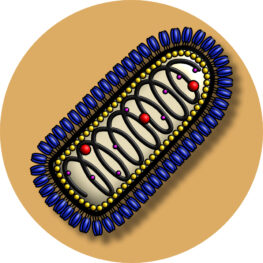“The SPARK award has been an incredible opportunity to learn how to communicate science to the community, design my own research project, and learn about the real logistics behind research grants.”
What if we could design longer-lasting vaccines?
Funded: January 2022
Funded By: The generosity of the Rosemary Kraemer Raitt Foundation Trust
What was the goal of your SPARK project?
Rabies is nearly 100% lethal, and untreated rabies infections kill over 50,000 people every year. While rabies vaccines and antiviral antibody therapies exist, they both have fundamental flaws that prevent their universal use. Rabies antiviral antibody treatment consists of polyclonal human serum and is derived from the blood of vaccinated volunteers. Additionally, rabies vaccines are only effective for a relatively short time after administration, making revaccination necessary. Post-exposure rabies treatment also consists of multiple doses of rabies vaccine in combination with human rabies immunoglobulin (HRIG). This combination treatment can be prohibitively expensive in many countries, especially in low-income countries.
I had two aims: 1) to test a stabilized form of rabies virus glycoprotein (RABV-G) as a vaccine candidate to determine if stabilization improved the longevity of the anti-rabies immune response, and 2) to identify new anti-rabies monoclonal antibodies for structural and functional characterization, as well as later development as a therapeutic candidate to replace HRIG. My long-term goal of this research is to develop new rabies vaccines and anti-viral antibody therapeutics to prevent rabies deaths.
Did you face any challenges?
The immunization strategy I used elicited good levels of serum antibodies, but I was surprised to detect there were unexpectedly few cells in the spleen that secreted anti-rabies antibodies. This finding warrants further investigation and could yield insight into why existing rabies vaccines elicit short-lived immunity.
SPARK project results:
I found that mice vaccinated with stabilized RABV-G produced a more uniform and longer-lasting anti-rabies antibody response, compared to mice vaccinated with unmodified RABV-G. Mice that received the unmodified RABV-G vaccine produced either very high or very low levels of antibodies, depending on the mouse. Mice that received the stabilized RABV-G vaccine, in contrast, produced a much more uniform immune response, with similar antibody levels from all mice.
I also isolated new anti-rabies antibodies from mice immunized with RABV-G and solved their protein structures in complex with RABV-G to determine where they bind. These antibodies bind to the side of RABV-G at slightly different angles. One antibody binds with relatively high strength, while the other antibody binds with intermediate strength.
These antibodies give me important information about what makes a strong anti-rabies antibody, and they are also potential therapeutics that can replace human rabies immunoglobulin as a rabies treatment.
What’s next for this project?
The data I have collected from this study shows that stabilized RABV-G is promising and it will allow me to continue to develop stabilized RABV-G as a new, improved, and long-lasting rabies vaccine. For my next steps, I need to try new vaccine formulations (for example, protein vaccines instead of DNA vaccines) and vaccination schedules to see if I can elicit greater numbers of anti-rabies antibodies, and directly compare my experimental vaccine(s) to commercial vaccines.
The new anti-rabies antibodies I isolated are also promising as candidate therapeutics, and will yield great insight into how antibodies act to neutralize rabies virus. I can use the structures I solved to pick out specific protein/protein interactions between RABV-G and antibodies, and I can introduce changes to the antibodies to engineer improved antibody therapeutics that bind with even greater strength or that can bind to glycoproteins from viruses related to rabies virus.
What’s next for Heather?
In August 2023, I began a position as Assistant Professor at Montana State University. As I establish my own lab, I also plan to write a paper on stabilized RABV-G and the results of my SPARK project. I also plan to analyze the polyclonal antibody response to vaccination with the wild-type and stabilized RABV-G vaccines using negative stain electron microscopy. Longer-term plans for this work include formulating the stabilized RABV-G vaccine as a protein, vectored, or liveattenuated vaccine and comparing the magnitude of the antibody response to that of commercial rabies vaccines.
